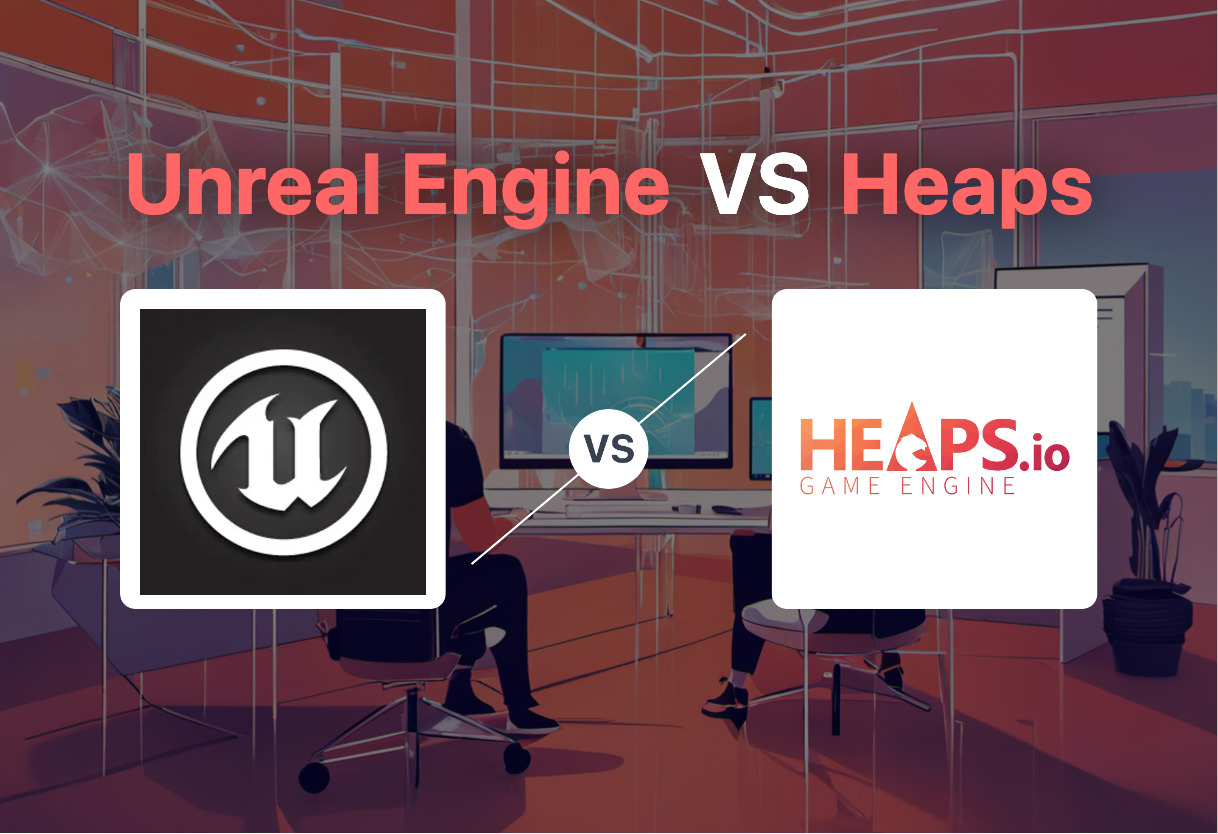For novice developers yearning to breathe life into simple games or apps, the lightweight and accessible Heaps is the go-to. But, if you’re aiming for a more advanced, multi-platform, 3D grandeur, the robust Unreal Engine reigns supreme.

Key Differences Between Unreal Engine and Heaps
- Coding: Unreal Engine uses C++, while Heaps leverages the Haxe programming language.
- Cost: Unreal Engine imposes a 5% cut on revenues over USD 1 million, whereas Heaps is free of such royalties.
- Development Capacity: Unreal Engine is optimized for large-scale 3D content, Heaps efficiently handles both 2D and 3D, but is especially suited for smaller, highly optimized games.
- Community/Support: Unreal Engine hosts a huge global community with a vast marketplace, while Heaps maintains a niche, indie-gaming specific community.
| Comparison | Unreal Engine | Heaps |
|---|---|---|
| Initial Display | Shown first with the game Unreal in 1998. | Developed behind hit games like Rushberry Mercs, Voidrun, and Nuclear Blaze. |
| Programing Language | C++ | Haxe |
| Affiliated Companies/Projects | Epic Games | Shiro Games, Motion Twin |
| 2D and 3D Capabilities | Yes | Yes |
| Template Options | Offers basic project templates for a first-person or third-person experience. | Used in various genres like Arcade, Role Playing, Real-time Strategy, and Turn-Based Strategy. |
What Is Unreal Engine and Who’s It For?
Unreal Engine (UE), developed by Epic Games, is a potent series of 3D computer graphics game engines, fundamentally used for game development. Primarily conceived for PC-first person shooters, UE expanded to encompass various game genres and industries, including cinema and TV. The most current release, Unreal Engine 5 (UE5), debuted in April 2022, redefining graphics potency. UE takes pride in supporting a myriad of platforms from desktop to VR, making it a versatile tool for game developers, film producers, and TV studios.

Pros of Unreal Engine
- Potent C++ game engine
- Support for multiple platforms
- Recent version UE5 features groundbreaking graphics
- Free for schools and universities
Cons of Unreal Engine
- 5% royalty on revenues over $1 million
- May have a steeper learning curve for the uninitiated.
What Is Heaps and Who’s It For?
Heaps, an effective cross-platform graphics engine leverages modern GPUs and the Haxe programming language to create high-performance games. An engine frequently used by indie developers, Heaps gains traction for its 2D as well as 3D capabilities. It’s the engine behind successful games like “Rushberry Mercs”, “Northgard”, and more. Shiro Gaming Company and Motion Twin are known users of Heaps. Owing to its library-like nature over a full-featured game engine, Heaps is a suitable choice for deep storylines and complex game systems.

Pros of Heaps
- Supports efficient cross-platform game development
- Ability to create rich 2D and 3D game experiences
- Suitable for complex game systems
Cons of Heaps
- Perceived as a library, not a full-fledged game engine
- Target audience is primarily indie game developers
Unreal Engine vs Heaps: Pricing
While Unreal Engine operates with a royalty model charging 5% of revenues over $1 million, Heaps provides no explicit pricing details and appears to be a free resource for developers.
Unreal Engine
The Unreal Engine employs a unique pricing model that charges developers for utilizing their engine, based on the revenue they generate. Epic Games, the software’s proprietor, collects a 5% royalty fee off gross revenues above $1 million that any project makes. This fee is dismissed for games published directly on the Epic Games Store. Additionally, Unreal Engine is offered free for educational institutions such as schools and universities.
Heaps
Heaps does not provide any explicit pricing information, suggesting that it is a free tool for developers to use. Being more of a library than a complete game engine, its adoption and usage costs are presumably absorbed by the development process. However, it’s crucial for prospective users to undertake their research or consultation for precise details on any possible hidden costs.
Code Examples for Unreal Engine & Heaps
Unreal Engine
This Unreal Engine example will implement a day-night cycle system. It is recommended that you are familiar with Blueprints Visual Scripting and Actor class, to comprehend this code effectively.
public class CustomSkyDome {
UPROPERTY(EditAnywhere, float);
UCurveFloat* SunHeightCurve;
UPROPERTY(EditAnywhere, float);
float dayLength;
UFUNCTION(BlueprintImplementableEvent, meta = (DisplayName = "Day Ended"));
void DayEnded();
UFUNCTION(BlueprintImplementableEvent, meta = (DisplayName = "Night Ended"));
void NightEnded();
UFUNCTION(BlueprintCallable, Category = "Sky")
void UpdateSun(float time);
UFUNCTION(BlueprintPure, Category = "Sky")
float GetSunHeight();
}Heaps
This Heaps example will create a simple sprite animation. You should have Haxe and Heaps installed for this instance to work flawlessly.
import h2d.Sprite;
class Main extends hxd.App {
var sprite : Sprite;
override function init() {
sprite = new Sprite(hxd.Res.loader.get("my_texture").toTile(), s2d);
}
override function update(dt:Float) {
sprite.x += dt * 100;
if (sprite.x > s2d.width)
sprite.x = -sprite.width;
}
static function main() {
new Main();
}
}Which Delivers Your Dream Game: Unreal Engine or Heaps?
Making a choice between Unreal Engine and Heaps might seem daunting, but it all narrows down to your requirements, proficiency, and your ultimate goal. Let’s dive in.
For Hardcore Developers Who Love to Experiment
If you are a hands-on developer who loves pushing boundaries with complex systems, Unreal Engine is the runtime for your imagination. From AAA games to immersive VR experiences, its powerful suite and C++ compatibility push the limits of game development. However, remember the 5% royalty after USD 1 million.

For Indie Developers with a Love for Community
Preferring tight-knit development communities and indie projects? Heaps has been your secret weapon all along. The Haxe-based engine gives you access to an active community. Enjoy the power behind titles like Dead Cells and Northgard, while focusing on deep storylines and game systems.

For Cross-platform Developers Needing Flexibility
Are you a cross-platform developer who prioritizes code portability? Heaps and its Haxe DNA embraces your productivity from Flash’s ashes. Combined with potential performance optimization and stability, achieving platform-independent benefits become a reality.

As a verdict, Unreal Engine captivates with powerful functionalities and vast platform support, yet it demands a higher learning curve and a royalty fee. Conversely, Heaps offers simplicity, an indie-friendly community and Haxe’s portability, though less feature-rich compared to Unreal. Your goal determines your tool.
Tiffany Brise
Content writer @ Aircada, patiently awaiting a consumer AR headset that doesn’t suck.





